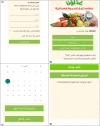Development and validation of a smartphone image-based app for dietary intake assessment among Palestinian undergraduates
- PMID: 36104377
- PMCID: PMC9472744
- DOI: 10.1038/s41598-022-19545-2
Development and validation of a smartphone image-based app for dietary intake assessment among Palestinian undergraduates
Abstract
Accurate dietary assessment is required in a variety of research fields and clinical settings. Image-based dietary assessment using smartphones applications offer the opportunity to reduce both researcher and participant burden compared to traditional dietary assessment methods. The current study, conducted in Palestine, aimed to design an image-based dietary assessment application, to assess the relative validity of the application as a dietary assessment tool for energy and macronutrient intake using the 3-Day Food Record (3-DFR) as a reference method, and to test its usability among a sample of Palestinian university students. The development of a smartphone application (Ghithaona) designed to assess energy and macronutrient intake is reported. The application validity was tested among a sample of Palestinian undergraduates from An-Najah National University. Participants recorded their dietary intake using the Ghithaona application over 2 consecutive days and 1 weekend day. Intake from the Ghithaona application were compared to intake collected from 3-DFR, taken on 2 consecutive weekdays and 1 weekend day, in the second week following the Ghithaona application. At the end of the study, participants completed an exit survey to test assess application usability and to identify barriers to its use. Mean differences in energy, and macronutrients intake were evaluated between the methods using paired t-tests or Wilcoxon signed-rank tests. Agreement between methods was ascertained using Pearson correlations and Bland-Altman plots. The Ghithaona application took 6 months to develop. The validation test was completed by 70 participants with a mean age of 21.0 ± 2.1 years. No significant differences were found between the two methods for mean intakes of energy or macronutrients (p > 0.05). Significant correlations between the two methods were observed for energy, and all macronutrients (r = 0.261-0.58, p ≤ 0.05). Bland-Altman plots confirmed wide limits of agreement between the methods with no systematic bias. According to the exit survey, it was found that majority of participants strongly agreed and agreed that the application saves time (94.2%), helps the participant to pay attention to their dietary habits (87.2%), and is easy to use (78.6%). The Ghithaona application showed relative validity for assessment of nutrient intake of Palestinian undergraduates.
© 2022. The Author(s).
Conflict of interest statement
The authors declare no competing interests.
Figures



Similar articles
-
Validity and Usability of a Smartphone Image-Based Dietary Assessment App Compared to 3-Day Food Diaries in Assessing Dietary Intake Among Canadian Adults: Randomized Controlled Trial.JMIR Mhealth Uhealth. 2020 Sep 9;8(9):e16953. doi: 10.2196/16953. JMIR Mhealth Uhealth. 2020. PMID: 32902389 Free PMC article. Clinical Trial.
-
Relative Validity and Reliability of the Remind App as an Image-Based Method to Assess Dietary Intake and Meal Timing in Young Adults.Nutrients. 2023 Apr 10;15(8):1824. doi: 10.3390/nu15081824. Nutrients. 2023. PMID: 37111043 Free PMC article.
-
Validation of a Smartphone Image-Based Dietary Assessment Method for Pregnant Women.Nutrients. 2017 Jan 18;9(1):73. doi: 10.3390/nu9010073. Nutrients. 2017. PMID: 28106758 Free PMC article.
-
Review of the validity and feasibility of image-assisted methods for dietary assessment.Int J Obes (Lond). 2020 Dec;44(12):2358-2371. doi: 10.1038/s41366-020-00693-2. Epub 2020 Oct 8. Int J Obes (Lond). 2020. PMID: 33033394 Free PMC article. Review.
-
A Systematic Review and Meta-Analysis of Validation Studies Performed on Dietary Record Apps.Adv Nutr. 2021 Dec 1;12(6):2321-2332. doi: 10.1093/advances/nmab058. Adv Nutr. 2021. PMID: 34019624 Free PMC article.
Cited by
-
Relative validity of an intelligent ordering system to estimate dietary intake among university students from a medical school in Shanghai, China.Int J Behav Nutr Phys Act. 2024 Jul 4;21(1):70. doi: 10.1186/s12966-024-01619-1. Int J Behav Nutr Phys Act. 2024. PMID: 38965619 Free PMC article.
-
Surveying Nutrient Assessment with Photographs of Meals (SNAPMe): A Benchmark Dataset of Food Photos for Dietary Assessment.Nutrients. 2023 Nov 30;15(23):4972. doi: 10.3390/nu15234972. Nutrients. 2023. PMID: 38068830 Free PMC article.
-
Shifts in food consumption patterns in the Levant: a systematic review of the last six decades.Int J Behav Nutr Phys Act. 2025 Apr 24;22(1):50. doi: 10.1186/s12966-025-01741-8. Int J Behav Nutr Phys Act. 2025. PMID: 40275353 Free PMC article.
-
Mobile Apps for Dietary and Food Timing Assessment: Evaluation for Use in Clinical Research.JMIR Form Res. 2023 Jun 16;7:e35858. doi: 10.2196/35858. JMIR Form Res. 2023. PMID: 37327038 Free PMC article.
-
Development and validation of food frequency questionnaire screener software for sodium intake among palestinian population.BMC Nutr. 2024 Sep 9;10(1):120. doi: 10.1186/s40795-024-00927-w. BMC Nutr. 2024. PMID: 39252140 Free PMC article.
References
-
- Mosleh M, Dalal H, Aljeesh Y. Burden of chronic diseases in the Palestinian health-care sector using disability-adjusted life-years. The Lancet. 2018;391:21. doi: 10.1016/S0140-6736(18)30346-5. - DOI
Publication types
MeSH terms
LinkOut - more resources
Full Text Sources
Miscellaneous

